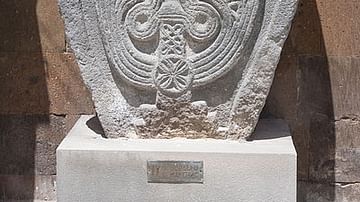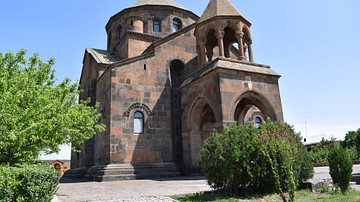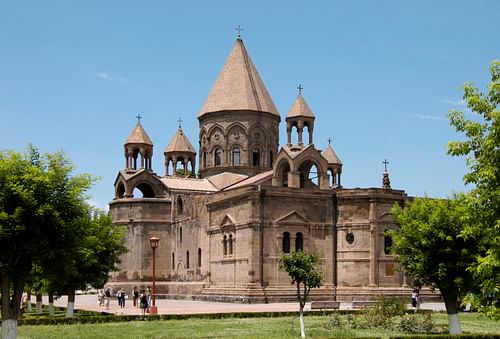
The Etchmiadzin Cathedral (also spelled "Echmiatsin,” “Echmiadzin,” and “Edjmiadsin”) is located in the city of Etchmiadzin (also referred to as Vagharshapat), Armavir Province in what is now present-day Armenia. It is geographically situated near the fertile valley of the Aras River, and it is not too far away from Mount Ararat, Armenia's capital, Yerevan, and Khor Virap Monastery. It is the spiritual center of the Armenian people, and the administrative center of the Armenian Apostolic Church. Called the “Mother Cathedral of Etchmiadzin” by Armenians, the cathedral is among the most ancient examples of Christian architecture anywhere in the world. Many scholars contend Etchmiadzin Cathedral is the oldest cathedral in Armenia, and it is widely believed that it is thus the oldest Christian cathedral in the world. The cathedral was designated as a part of a UNESCO World Heritage zone in 2000 CE — the zone also encompasses St. Gayane Church, St. Hripsime Church, and the archaeological ruins of Zvartnots Cathedral — due to its importance in Armenian religious and cultural history.
Armenia's Sacred Cathedral
The area surrounding Etchmiadzin Cathedral has been inhabited by various peoples since prehistoric times. Stone, Bronze, and Iron Age archaeological sites are located in or close around the city and cathedral. The area was well-known by the ancient people of Urartu; Etchmiadzin is referred to as "Kuarlini" in a Urartian cuneiform inscription, and the oldest documented information concerning Etchmiadzin's environs date from the reign of King Rusa II (r. 685-645 BCE). The city of Vagharshapat — today more commonly referred to as “Etchmiadzin” — was founded during the reign of the Arsacid king Vagharsh I (r. 117-140 CE). Although it was the capital city of Armenia for a time, the city's fortunes ebbed as it was attacked and destroyed during the Sasanid invasions of 368-369 CE. Soon thereafter, Vagharshapat was replaced as the political capital by Dvin in the 4th century CE. The city, however, remained prosperous due to its ideal position in the trade routes between the Roman Empire and Sasanid Persia. During the reign of Tiridates the Great (r. c. 298 - 330 CE), Christianity was adopted as Armenia's state religion, and Tiridates himself converted in 301 CE in the royal palace at Vagharshapat according to legends and Armenian historians.
The subsequent construction of Etchmiadzin Cathedral at Vagharshapat can be attributed to the life and work of Saint Gregory the Illuminator (also known as Grigor Lusavorich, c. 239 - c. 330 CE). If Armenian legends and historians are to be believed, Jesus Christ appeared to Saint Gregory the Illuminator in a vision, requesting that a cathedral be built within the ancient city. In the vision, Jesus Christ showed the exact spot where the proposed structure should lie, striking the ground with a golden hammer in his hands. Construction of Etchmiadzin Cathedral began around c. 303 CE. The cathedral was dedicated in turn to the Virgin Mary, and aptly named “Etchmiadzin” or “the descent (echnel) of the only begotten (miatsin).”
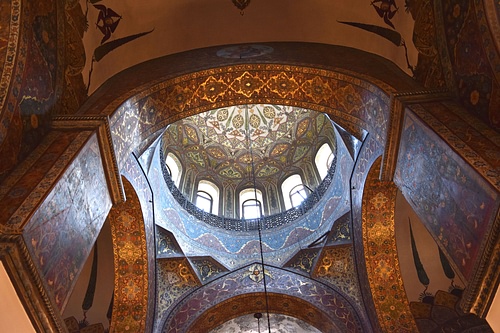
From the 5th to the mid-7th centuries CE, the city of Etchmiadzin grew quickly, developing into a major center of culture and pilgrimage. Successive bishops, over these two centuries, guaranteed the construction of further ecclesiastical buildings in close proximity to Etchmiadzin Cathedral, stimulating an epoch of Armenian cultural fluorescence. In the 7th century CE, under the guidance of the bishop Komitas of Aghdzk (r. 615-628 CE), Etchmiadzin began to pull in even more pilgrims following the construction of the Church of Saint Hripsime, which was named after the virgin who had been martyred by Tiridates the Great prior to his conversion to Christianity. The church of Saint Gayane was added around 616 CE and, in the 650s CE, the completion of the splendid Zvartnots Cathedral only added to the attractions, ensuring the city of Etchmiadzin became one of the most important pilgrimage sites in Armenia. The cathedral's wealth and reputation grew in importance in tandem with that of the city, attracting pilgrims from across the Christian Near East.
In 640 CE, following the invasion and occupation of Armenia by the Arabs under the Rashidun Caliphate (632–661 CE), the position of Etchmiadzin Cathedral and the city as a major religious center became precarious. Dvin and then Ani became Armenia's political and religious capitals, and the city of Etchmiadzin and its cathedral slowly fell into a period of decline. A major earthquake struck the region in the 10th century CE which caused the collapse of the Cathedral of Zvartnots, amongst other buildings, and the Seljuk Turks raided the area in the mid-11th century CE. By the late 13th century CE, after the onslaught of the Mongols in Armenia and Georgia, the environs surrounding the cathedral were so dilapidated that the celebrated Armenian poet Stepanos Orbelian (d. 1304 CE) felt compelled to compose his Lamentations on the Holy Cathedral of Vagharshapat.
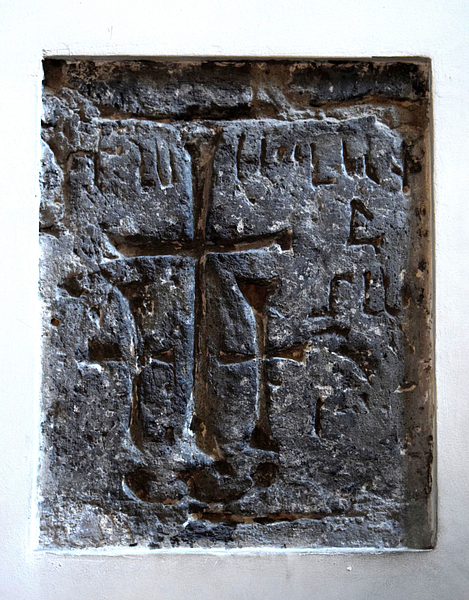
The Cathedral of Etchmiadzin's fortunes revived, however, when the Armenian Apostolic Church decided to restore the catholicosate to the site in the mid-15th century CE. The country and its Christian population endured hardship and intermittent warfare with Safavid Iran under Ottoman Turkish rule, but the cathedral was given certain economic privileges, which enabled it to function until better days arrived. Construction and restoration projects occured in the 18th and 19th centuries CE, returning some lustre to the old cathedral. Imperial Russian rule (1827-1917 CE) gave the cathedral nearly a century of stability. While suppression returned in the early days of the USSR (1918-1949 CE), Etchmiadzin Cathedral endured and remains the “Holy Mother See of all Armenians.”
Architecture & Archaeology
The cathedral is 33 m (108 ft) long and 30 m (98 ft) wide with a height of over 20 m (65 ft). As a result of renovations and restorations over a period of many centuries, Etchmiadzin Cathedral's exterior is a mix of Armenian architectural and artistic styles. Of special note are the reliefs on the northern wall of the cathedral, which depict Saint Paul the Apostle (c. 5-67? CE) and Saint Theclas (c. 30-? CE).

Archaeological evidence from inside the crypt of the Etchmiadzin Cathedral suggest that the cathedral was built intentionally on the site of a pagan fire altar. Ensuing excavations from 1955-1959 CE revealed the ruins of an old Christian church with stone and wooden interior walls. This structure was most likely the one ordered by St. Gregory the Illuminator in the early 4th century CE. The contemporary outline and shape of the cathedral, which stands at the site today, dates to c. 483 CE after the then Governor of Armenia Vahan Mamikonian commissioned a renovation on Saint Gregory the Illuminator's first structure. The renovations were a compensation, perhaps, for the moving of the Armenian Apostolic Church's headquarters to Dvin in 485 CE, but other scholars suggest that a fire might have damaged the earlier structure. Etchmiadzin Cathedral was reconstructed along the lines of a square plan rather than that of the longitudinal plan of the older church and other Christian basilicas. Further renovations occurred in the 7th century CE when stone replaced the older one made of wood.
In the later centuries, architects added a belfry to the cathedral in 1653 CE and a sacristy was added in 1868 CE. Schools, refectories, a hostel, and other structures were built alongside the cathedral between the 17-19th centuries CE. Rotundas on four-pillar bases were built in the 18th century CE, and the lovely frescoes inside the cathedral were completed by Naghash Hovnatan between 1712-1721 CE.
This article was made possible with generous support from the National Association for Armenian Studies and Research and the Knights of Vartan Fund for Armenian Studies.





